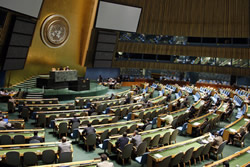HIV traps Asian households in vicious circle of joblessness, debt
HIV traps Asian households in vicious circle of joblessness, debt
01 December 2011
School enrollment, nutrition also suffer, new study says
Bangkok —Households in Asia that include people living with HIV exhaust their savings and liquidate assets at a disproportionately high rate, often plunging into “irreversible poverty,” according to a new UN Development Programme (UNDP) study, released today.
Catastrophic health care costs, stigma, unemployment, and bad credit also mean these households—which start out with fewer assets—consume less food of lower quality and keep fewer children in school, the report said.
The report, Socio-Economic Impact of HIV at the Household Level in Asia: A Regional Analysis, calls for urgent mitigation measures, including HIV-sensitive social protection, to arrest this rapid socio-economic decline of tens of thousands of households in the region.
“The study clearly demonstrates the severity of the impact of HIV on households and the need for sustainable impact mitigation steps, ideally integrated into the social protection schemes targeted at vulnerable and marginalised populations,” said Nicholas Rosellini, Deputy Assistant Administrator and Deputy Regional Director, UNDP Regional Bureau for Asia and the Pacific. “Without intervention, many of them will slip into irreversible poverty,” she added.
Reduced enrollment and higher drop-outs rates among children from HIV-affected households demonstrate HIV’s toll on human capital.
Children in HIV-affected households in China, India, Indonesia, and Viet Nam are less likely to attend school than those from non-HIV-affected households, the study found. Children from the poorest households, as well as girls, suffer more. Girls fare particularly badly in terms of school drop-outs as well.
Within households of people living with HIV, the impact on women is considerably higher – taking care of the ill at home and working outside the house to earn extra income needed to cope with the economic burdens of HIV.
The study found that HIV-affected household members in China, Indonesia, and Viet Nam are also more often jobless, frequently because they are infected with HIV.
Stigmatised and Trapped in Debt
In all the countries surveyed, HIV-affected households extinguish their savings and liquidate assets far more commonly than non-HIV-affected households, particularly in Cambodia, China, Indonesia, and India.
While most households end up in debt, many also find borrowing difficult because of their adverse “creditworthiness,” forcing them to borrow from money-lenders at higher interest rates that trap them in debt.
“The answer lies in HIV-sensitive social protection,” Clifton Cortez, Regional Practice Leader for HIV, Health, and Development, said. “It’s a question of tailoring social protection initiatives to address the socio-economic vulnerability of HIV households.”
The report also notes pervasive stigma and discrimination in all spheres of life, including in community and state institutions, employment, and domestic and social spaces. Discrimination most commonly occurs as social isolation, verbal abuse, and harassment.
The report is based on national studies undertaken by UNDP in partnership with national institutions in Cambodia, China, India, Indonesia, and Vietnam over the last six years. National studies compared HIV-affected and non-HIV-affected households with similar socio-economic backgrounds, comprising 17,000 households and 72,000 individuals.
With the exception of Cambodia, health spending as a share of overall consumption is substantially higher in HIV-affected households compared to non-HIV-affected households: HIV-affected households in India, Indonesia, and Viet Nam spend three times more on health than non-HIV-affected-households.
In Cambodia, HIV-affected-households spend less on health, most likely because of the country’s near-universal coverage of anti-retroviral (ARV) treatment for HIV. Cambodia’s ARV coverage among women and lesser discrimination at health facilities are also notable.
Downloads
The Socio-Economic Impact of HIV at the Household Level in Asia: A Regional Analysis
###

###
> United Nations (UN).
 The United Nations was established on 24 October 1945 by 51 countries committed to preserving peace through international cooperation and collective security. Today, nearly every nation in the world belongs to the UN: membership totals 192 countries.
The United Nations was established on 24 October 1945 by 51 countries committed to preserving peace through international cooperation and collective security. Today, nearly every nation in the world belongs to the UN: membership totals 192 countries.
When States become Members of the United Nations, they agree to accept the obligations of the UN Charter, an international treaty that sets out basic principles of international relations. According to the Charter, the UN has four purposes:
- to maintain international peace and security;
- to develop friendly relations among nations;
- to cooperate in solving international problems and in promoting respect for human rights;
- and to be a centre for harmonizing the actions of nations.
###
* The above story is adapted from materials provided by United Nations (UN)
** More information at United Nations (UN)



















